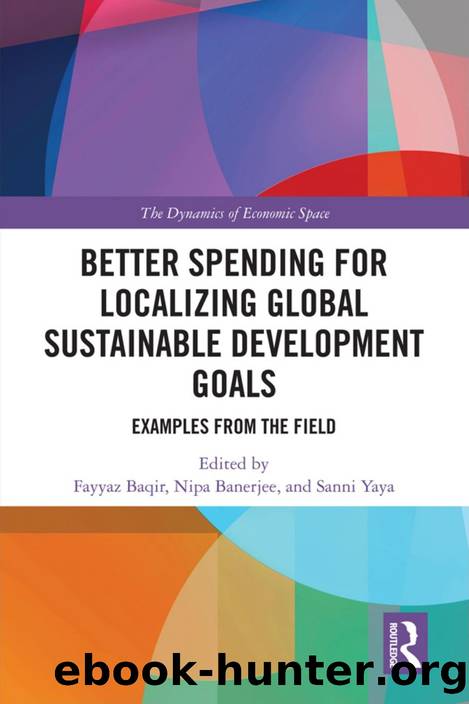Better Spending for Localizing Global Sustainable Development Goals: Examples From the Field by Fayyaz Baqir & Nipa Banerjee & Sanni Yaya

Author:Fayyaz Baqir & Nipa Banerjee & Sanni Yaya [Baqir, Fayyaz & Banerjee, Nipa & Yaya, Sanni]
Language: spa
Format: epub
ISBN: 9780367338459
Amazon: 0367338459
Published: 0101-01-01T00:00:00+00:00
8
Market-led development
Shakeel Ahmad1
Markets and the private sector could play an instrumental role in social development. This chapter argues that donors spending for developing markets for social and economic development is one of the better spending models. It presents the story of how the microfinance market in Pakistan has evolved through donor funding. It discusses how donors have aligned their support to the different phases of the development of the microfinance industry from pure grant-based funding, to limited subsidies, and to purely commercial lending. In doing so, the donors have not only developed self-sustaining microfinance institutions but have also been able to leverage limited financing for a much larger impact at scale. The chapter provides examples and case studies from Pakistan, where aid was used to help establish self-sustaining and profitable social businesses generating social impact at scale. Developing and strengthening markets for the delivery of social goods has emerged as an innovative model for the âbetter spendingâ of aid that yields high social returns for donors and recipient countries alike.
Keywords
Social development, markets, private sector, microfinance, Sustainable Development Goals, impact financing
Introduction
In December 2012, United Nations Development Programme (UNDP) undertook the impact assessment of one of its Rural Development Projects which was concluded five years back. The objective was to assess the post-project impact and sustainability of activities or models introduced by a five-year project titled Lachi Poverty Reduction Project (LPRP), implemented during 2002â2007. The main findings of the evaluation were that the microfinance model of the project had survived and was still operating on its own. The microfinance programme was up and running and was providing services to its clients even after the closure of the project five years back.
The microfinance component of LPRP was a small component: not more than 10% of the project budget was spent on it. However, it was different from the rest of the projectâs components in the sense that it was a loan programme, whereas all other components were based on grants. The model was such that grant money the project received was converted into a ârevolving credit pool.â The money was lent to the clients as a standard microfinance product. It was a self-sustaining enterprise recovering its operational and capital costs from the loan operations.
The stories of other microfinance institutions are not different from LPRPâs microfinance programme. Today, the microfinance industry in Pakistan is estimated to have a potential market size of 20.5 million clients. It has reached this level over a period of approximately 22 years. As of December 2018, the micro-finance industry has had a client base of 6.9 million active borrowers, gross loan portfolio of Rs. 274.7 billion (around US$2 billion),2 and a total assets base worth of Rs. 330 billion (around US$2.35 billion). The industry may not be the biggest or most fascinating in South Asia, but it is a great example of how international aid has built a self-sustaining and self-expanding microfinance market.
In this case story, we will present how the donorsâ money was used to develop the markets for microfinance services.
Download
This site does not store any files on its server. We only index and link to content provided by other sites. Please contact the content providers to delete copyright contents if any and email us, we'll remove relevant links or contents immediately.
Zero to IPO: Over $1 Trillion of Actionable Advice from the World's Most Successful Entrepreneurs by Frederic Kerrest(4074)
Machine Learning at Scale with H2O by Gregory Keys | David Whiting(3657)
Harry Potter and the Goblet Of Fire by J.K. Rowling(3618)
Never by Ken Follett(3547)
Ogilvy on Advertising by David Ogilvy(3351)
Shadow of Night by Deborah Harkness(3181)
The Man Who Died Twice by Richard Osman(2820)
Book of Life by Deborah Harkness(2726)
My Brilliant Friend by Elena Ferrante(2707)
How Proust Can Change Your Life by Alain De Botton(2620)
0041152001443424520 .pdf by Unknown(2608)
Will by Will Smith(2591)
The Tipping Point by Malcolm Gladwell(2566)
How to Pay Zero Taxes, 2018 by Jeff A. Schnepper(2505)
Purple Hibiscus by Chimamanda Ngozi Adichie(2502)
Hooked: A Dark, Contemporary Romance (Never After Series) by Emily McIntire(2428)
Rationality by Steven Pinker(2158)
Borders by unknow(2121)
Daughter of Smoke and Bone by Laini Taylor(2086)
